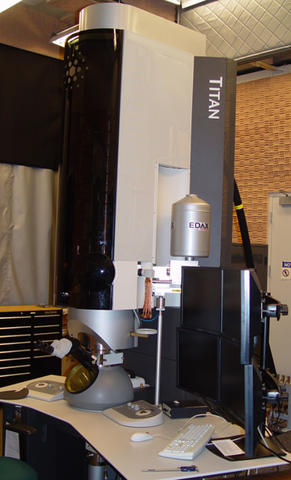Analytical Electron Microscope

The Titan 80-300 is a transmission electron microscope (TEM) equipped with spectroscopic detectors to allow chemical, elemental, and other analytical measurements to be performed at high spatial resolution. The Titan operates between 80 keV and 300 keV electron beam energy, and uses a thermal (Schottky) field emission electron source to illuminate the sample. It can be used in full-field imaging mode as both a conventional TEM and a phase-contrast high resolution TEM for imaging the atomic scale lattice in many materials. It can also be used as a high resolution scanning transmission electron microscope (STEM), where a finely focused electron beam is scanned across the sample and an image is formed using one of several available electron or spectroscopic signals. This latter mode is particularly useful for performing elemental and chemical analyses of very small analytical volumes. The Titan is also equipped with a CEOS GmbH double-hexapole spherical-aberration corrector, which allows for the formation of a ~100 pm STEM probe, enabling atomic-scale imaging and analysis. The above capabilities are supplemented by a full suite of electron diffraction capabilities, including selected area electron diffraction (SAED) and convergent beam electron diffraction (CBED). These diffraction modalities allow the instrument to probe the crystallographic phase and microstructure of samples in addition to their structural and chemical properties.
Two analytical spectrometers are also present on this system: a post-column Gatan Imaging Energy Filter (GIF) and an EDAX r-TEM X-ray energy dispersive spectrometer (XEDS). The GIF can function as a conventional parallel electron energy-loss spectrometer (EELS) to record spectra of the energy losses experienced by the beam electrons as they scatter from sample atoms. It can also be used as an imaging energy filter to form energy-selected TEM images. This enables nanoscale elemental imaging methods such as energy filtered transmission electron microscopy (EFTEM). A Wien-filter monochromator below the electron gun improves the energy-resolution of these techniques significantly to ~ 0.3 eV. The presence of dual spectrometers allows for the simultaneous EELS and XEDS hyperspectral imaging at very high spatial resolution.
Finally, the instrument is capable of carrying out semi-automated specimen tilt series acquisitions (Xplor3D), which enables three-dimensional tomographic analyses at nanoscale resolution.
Specifications/Capabilities
* 80 to 300 keV electron beam energy
* Super-Twin Alpha objective lens pole piece
* +/- 80 degrees specimen tilt
* high-tilt tomographic and chemical/analytical experiments possible
* tomographic, low-background, heating, cryo, double tilt, double tilt plus rotate specimen holders
* electron energy-loss spectroscopy (EELS), with 0.3 eV energy resolution* imaging energy filter
* energy filtered imaging (EFTEM)
* Si(Li) X-ray energy dispersive spectrometer (XEDS)
* approximately 0.23 nm point-to-point spatial resolution in TEM mode
* approximately 0.1 nm STEM spatial resolution
* selected area electron diffraction modes
* convergent beam electron diffraction modes
* Lorentz lens for imaging of magnetic specimens
* High-angle annular dark-field STEM detector
* 1k and 2k CCD's
Scientific Opportunities/Applications
* tomographic imaging and 3D elemental distributions
* nanoparticle imaging and chemical characterization
* magnetic nanostructure characterization
* catalyst particle morphology, structure, and chemistry
* atomic-resolution imaging and analysis
Usage Information
Access Information
Individual collaborative projects to address NIST measurement needs are possible when the work is consistent with the Materials Measurement Science Division mission space. Contact Andrew Herzing or to discuss possible collaborations.

